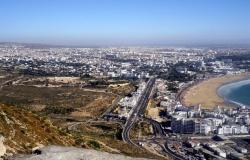Since October, CERN has been carrying out a geological study phase for the construction of its Future Circular Collider. This FCC will be installed in a circular tunnel 91 km long, between Geneva, Haute-Savoie and Ain, and approximately 5 meters in diameter, between 100 and 300 meters underground. But an FCC which raises many concerns. Arnaud Marsollier, the CERN spokesperson, was the guest of Béatrice Rul at 7:30 a.m.
CERN wants to build this Future Circular Collider. The geological field studies phase began at the beginning of October. What is the FCC?
“We are currently carrying out a feasibility study, that is to say we are looking at whether we could make this new machine after the Large Hadron Collider. It would be 90 km long to go even deeper into the understanding of the Higgs boson and the world of particles We already have a good understanding of the geological terrain but to confirm certain aspects: to verify certain aspects of the subsoils, the stability of the subsoils, the positioning of the accelerator. uses vibrating trucks which allow to map the subsoil or to do in certain places what we call coring, that is to say holes a little deep to see the nature of the subsoil.
“We are not going to build a particle accelerator in the middle of the city”
Vibrator trucks are used for this phase of studies. We remember that for geothermal energy for SIG, vibrating trucks had also been used, with consequences for houses in certain municipalities. Are CERN’s vibrating trucks safe?
“I think there is no problem. These vibrator trucks are made for geological studies and have been used for a very, very long time. We also do that in the countryside, so rather in places where there is no problem. “There are no houses. We’re not going to build a particle accelerator in the middle of the city, that’s not the aim of the game.”
“The project as the designer wants it, to design it, will obviously take into account all environmental issues”
The FCC will be installed in a circular tunnel 91 km long, between Geneva, Haute and Ain, and approximately 5 meters in diameter, between 100 and 300 meters underground. It’s gigantic…
“Obviously, we are making big projects, but if we look back a little, today we still have an accelerator that is 27 km long, which is unique in the world, and if we go to the Pays de Gex side, CERN is a little bit everywhere but we don’t see it, it is essentially underground. There are fears, environmental concerns are something that is very important for us. that CERN is probably quite The project as we want it to be designed and designed will obviously take into account all environmental issues. These concerns are also part of the concerns of the feasibility study: to see under what conditions and with what impact. to be done the FCC, it is a big project, a big project has an impact, and a big project is a big responsibility. We are indeed committed to working to limit the impact as much as possible. example, our machines generate a little heat and we reuse a part of the heat that is generated by our machines rather than sending it into the atmosphere to heat a neighborhood, to heat buildings. This is something that we will look at very closely for our new major project.”






